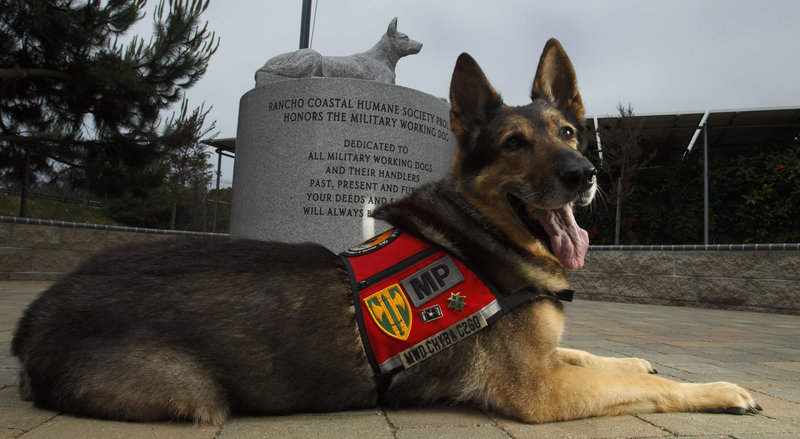SAN DIEGO — Life after the military is looking brighter than ever for America’s four-legged veterans since one of their own helped in the mission to kill Osama bin Laden.
War dog organizations say the number of people asking about adopting retired military canines has risen dramatically since the mission involving Cairo, the Navy SEALs dog tasked with tracking anyone who tried to escape from bin Laden’s compound and alerting the special operations forces to anyone approaching.
While about 300 retired U.S. military dogs are put up for adoption each year, military officials say they’ve received more than 400 adoption applications in the three weeks since the May 2 raid. In past generations, most military dogs were euthanized once their tours of duty were done.
“They made a really big deal about Cairo being a super dog but all dogs in the military are super dogs,” said Ron Aiello, president of the U.S. War Dogs Association. “These dogs are fully trained, are worth probably $40,000 to $50,000 each at least, and it’s a dog that has been saving American lives. It’s kind of a hero in a way.”
Aiello, a dog handler for the Marine Corps during the Vietnam War, started his organization with other former dog handlers to teach Americans about the long and often sad history of the dogs that have been deployed with troops.
The attack on Pearl Harbor sparked the U.S. military’s interest in war dogs, which Germany and France used in World War I. Prior to the Vietnam War, the canines were trained to be fierce attack dogs that greatly distrusted humans. But the military soon found that limited them too much and started training German shepherds and other breeds to be patrol dogs.
Today, military dogs are used to find explosives, insurgents and drugs, and to help search for missing people. Some are so highly trained they can work off leash and follow commands whispered by their handlers through a specialized communication system attached to the dog.
The dogs are credited with saving thousands of lives. Last year, Aiello said, a dog on patrol in Iraq detected a fertilizer bomb on the other side of the door in a building. The dog sat down and alerted U.S. troops, who spotted the explosive by looking under the door.
If the dog had not sat down, troops would have opened the door and the building might have blown up, killing all inside.
Other times, the dogs can only do so much. When a sniper’s bullet struck Pfc. Colton Rusk in Afghanistan, the first to reach his body was his best friend Eli – a bomb-sniffing, black Labrador so loyal he snapped at other Marines who rushed to his fallen handler. Rusk died Dec. 6. His parents have since adopted his dog.
After the Vietnam War, only 204 of an estimated 4,900 war dogs returned to the United States, according to military dog organizations. The others were euthanized, given to the South Vietnamese army or abandoned by soldiers trying to save the dogs.
That changed in 2000 when President Bill Clinton signed a law allowing the dogs to be adopted. Dog lovers say the military has made dramatic strides since then. Last year, 338 dogs were adopted, including 34 that were given to police departments or other government agencies.
None are euthanized now, said Gerry Proctor, a spokesman for Lackland Air Force Base in San Antonio, where the military’s dog adoption program is based.
“All the animals find a home,” he said. “There’s a six-month waiting list right now for people wanting to adopt.”
Send questions/comments to the editors.



Success. Please wait for the page to reload. If the page does not reload within 5 seconds, please refresh the page.
Enter your email and password to access comments.
Hi, to comment on stories you must . This profile is in addition to your subscription and website login.
Already have a commenting profile? .
Invalid username/password.
Please check your email to confirm and complete your registration.
Only subscribers are eligible to post comments. Please subscribe or login first for digital access. Here’s why.
Use the form below to reset your password. When you've submitted your account email, we will send an email with a reset code.